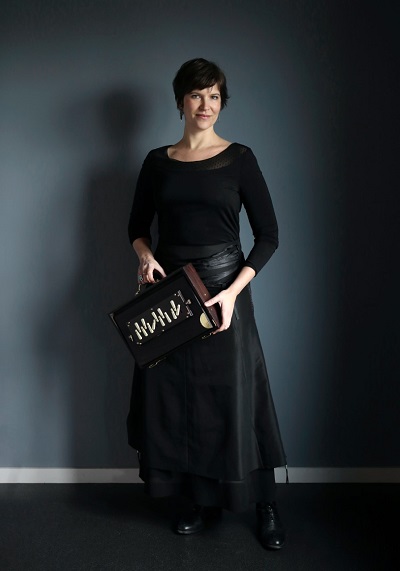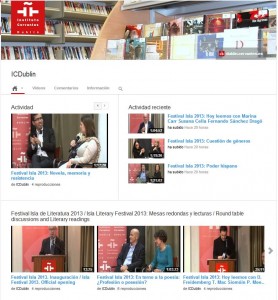Blog del Instituto Cervantes de Dublín
Torre Martello
De camino a Sefarad con Katerina García | Searching for Sepharad with Katerina García
La académica y cantante Katerina García habla de los judíos sefardíes y la expresión de la identidad mediante la música con motivo del Día Internacional de la Lengua Materna (21 de febrero).

Sefarad es una denominación bíblica hebrea de la península ibérica. De ahí viene el nombre de los sefardíes, los judíos que vivían en la región de la España actual. Esta etnia perdió su territorio de origen en 1492 al ser expulsada por los Reyes Católicos. Desde entonces, los sefardíes se han extendido por todo el mundo, desde los Balcanes y Grecia hasta el norte de África. El Instituto Cervantes de Dublín conversa con la investigadora en la cultura sefardí, Katerina García, sobre dos de los elementos que mantienen unido a un grupo tan diseminado: la lengua y la música. También encontramos algunos paralelismos con el destino de Irlanda.
Los sefardíes hablan una lengua que nunca ha sido oficial en ningún país: el judeoespañol. Carece de una gramática normativa publicada y se desarrolla de forma muy orgánica, hablada sobre todo en casa o entre familiares. No obstante, en las últimas décadas ha crecido enormemente el interés académico en su estudio. Tiene una base lingüística del castellano medieval con un componente semítico (hebreo). Los numerosos países en los que viven actualmente los sefardíes también han influido mucho en el judeoespañol. Hay palabras turcas, griegas, eslavas e incluso árabes prestadas que escuchamos en muchas canciones compuestas en esta lengua.
Katerina García es una investigadora e intérprete verdaderamente multicultural. Nació en la República Checa, creció en España, se doctoró en la Universidad Carolina de Praga y actualmente vive en Irlanda. Imparte clases en el Departamento de Estudios Hispánicos de Trinity College Dublin donde desarrolla su carrera musical. Dice que su interés por el tema principal que investiga—la música sefardí— proviene de su trayectoria personal. Lo que más le atrae es el sincretismo de elementos culturales presentes en su música y lengua. La música sefardí es especial por su diversidad: además de basarse en una lengua y cultura hispánica, incorpora motivos turcos, griegos y norteafricanos, en función del territorio donde se encuentra cada comunidad sefardí y sus tradiciones musicales.
Tras la inmensa pérdida de población sefardí europea durante la Segunda Guerra Mundial y la asimilación lingüística, se produjo un declive del uso del judeoespañol. Los elementos de la tradición, como la cocina o la música, se convierten en importantes espacios para el mantenimiento de memorias colectivas. La música, en particular, contribuye a salvaguardar y difundir una lengua que se encuentra gravemente amenazada gracias a que es capaz de evocar fuertes emociones.
Katerina menciona que, mientras que la música sefardí va forjando su identidad en la diáspora, ella no puede evitar ver similitudes en el destino musical de los irlandeses. Tanto irlandeses como sefardíes se extienden por el mundo creando una música étnica de gran impacto. La música irlandesa a menudo atrae al público local e internacional, aunque las letras no siempre se entiendan. La música ayuda a sobrepasar barreras lingüísticas.
Las similitudes históricas y culturales entre las dos diásporas hacen que demuestren interés mutuo. Katerina nos recuerda un ejemplo de esta peculiar fusión: Matt Darriau y Lisa Gutkin, dos de los miembros de la banda neoyorquina de klezmer-jazz The Klezmatics, actuaron, al mismo tiempo, en un conjunto de música celta fusión, Whirligig. Y menciona también una canción que conmemora cómo la cultura de las dos etnias contribuyó a la creación de los Estados Unidos: If it wasn’t for the Irish and the Jews.
Hay varios artistas que experimentan con la música sefardí. Generan un aura de medievalismo y antigüedad a su alrededor, motivada especialmente por los vínculos intertextuales que unen el romancero sefardí con el romancero hispánico. Sin embargo, Katerina destaca que, aunque hay ejemplos muy antiguos de esta música, la mayor parte de las canciones sefardíes conocidas por el público de hoy se compusieron en la diáspora, después de 1492. Por ello, al trabajar en esta música, Katerina la presenta como su visión particular de la tradición sefardí, sin intención de apropiarse de ella. Asimismo, c que la identidad musical de los sefardíes prosperará mediante interpretaciones informadas y respetuosas con la tradición, mezcladas con una dosis sana de innovación y experimentación.
Os presentamos algunos músicos modernos que trabajan con la tradición musical sefardí:
- Mor Karbasi, que combina la riqueza de su legado musical sefardí con elementos de otras músicas, entre ellas el flamenco.
- Yasmin Levy, que incorpora elementos de música contemporánea para un sonido “moderno”.
- Mara Aranda, cantante y compositora valenciana especialista en música antigua, reconocida internacionalmente por sus grabaciones de cantes tradicionales de la diáspora sefardí, en especial de Marruecos.
- Vanessa Paloma Elbaz, intérprete, etnomusicóloga y destacada especialista en la tradición musical de los judíos de Marruecos.
Recientemente, Katerina ha vuelto a los escenarios, tras dos años sin poder actuar en vivo con su grupo dublinés. El concierto, parte del programa del festival Mother Tongues Festival, incluyó un repertorio variado de canciones bohemias, irlandesas y sefardíes e incluso enseñaron al público una canción en judeoespañol.
Texto: Ekaterina Dragalina
Academic and musician Katerina García talks about the Sephardic Jews and the quest for identity through music. Today’s talk is dedicated to International Mother Language Day, which takes place on 21st February.
Sepharad is the biblical Hebrew denomination of the Iberian Peninsula. That is where the name of the Sephardi – the Jews who lived in the region of modern Spain – comes from. This ethnic group lost their home territory in 1492 after being expelled by the Catholic Monarchs. Since then, the Sephardi have spread all over the world, from the Balkans and Greece to North Africa. Instituto Cervantes Dublin had a talk with researcher of Sephardic culture, Katerina García, about the two of the elements that keep such a disseminated group together – language and music. We also found some parallels with the fate of the Irish nation.
The language of Sephardic Jews has never been official in any country. It is called Judeo-Spanish. It does not have an officially published, normative grammar and develops in a very organic way, spoken mostly at home or between family members. Nonetheless, it has seen a dramatic surge in academic interest in recent decades. It has a linguistic base of Medieval Castilian, with a Semitic (Hebrew) component. The numerous countries where the Sephardi people live now have also influenced Judeo-Spanish greatly. In many songs composed in this language we can hear words of Turkish, Greek, Slavic and even Arabic origin.
Katerina García is a truly multicultural investigator and performer. She was born in the Czech Republic, grew up in Spain, pursued a PhD at the Charles University of Prague and currently lives in Ireland. She teaches at Trinity College’s Department of Hispanic Studies and pursues her musical career. That said, she mentioned that her interest in Sephardic music comes from her background. It is the syncretism of cultural elements in this music and its language that attracts her the most. In very broad and generalizing terms, Sephardic music is extraordinary because of its diversity: being based on a Hispanic language and culture, it also has Northern African, Turkish, or Greek motifs, depending on the geographical area and its musical tradition.
There has been an ensuing gradual decline in the use of Judeo-Spanish after the enormous tragedy of the Second World War, which affected very drastically the Sephardic population of Europe. Now it is mostly traditions such as music, or cooking, to name a few, which are so important for the maintaining of collective memories. Music in particular has the ability to evoke strong emotions and, at the same time, it can perpetuate a language that has been, since the War, severely endangered.
Link to a video of Katerina performing in Judeo-Spanish with her band, Kon Sira
Katerina mentioned that, as the Sephardic music takes shape and forges its identity in the diaspora, she cannot help but see similarities in the musical destiny of the Irish. After all, Both the Irish and the Sephardic Jews are disseminated all over the world and created ethnic music of very big impact. Irish music often attracts local and international listeners, and this interest reaches across the boundaries of languages.
Historical and cultural similarities between the two diasporas often resulted in them showing interest in one another. Katerina remembered an example of such a peculiar fusion – musicians Matt Darriau and Lisa Gutkin from the New York-based Klezmer-Jazz band The Klezmatics, also performing in a Celtic fusion band called Whirligig. She also recalled a song that commemorates how the cultures of the two ethnicities contributed to the “building” of the United States: “If it wasn’t for the Irish and the Jews”.
Link to the song “If it wasn’t for the Irish and the Jews by Mick Moloney: YouTube
Many artists experiment with Sephardic music and sometimes surround it with an aura of medievalism and remoteness, mostly based on the documented intertextual links between the Sephardic and Spanish romanceros. However, Katerina emphasizes that, even though there are some ancient examples of this music, most of the Sephardic songs that are known among the public today were composed in the diaspora, after 1942. As for herself, while working on her music, she presents it as her own vision of the Sephardic tradition, without any intention to appropriate it. She believes that the musical heritage of the Sephardi people will thrive through an informed and respectful interpretation, combined with a healthy degree of experimentation and innovation.
Here are a few modern musicians that work with the Sephardic musical tradition:
- Mor Karbasi, who combines her Sephardic musical heritage with other diverse influences, including Flamenco
- Yasmin Levy, who uses a range of modern musical influences to create a contemporary style
- Mara Aranda, Valencian singer and composer, specialist in Early music, most recently known for her recordings of traditional Sephardic, and in particular Moroccan, cantes
- Vanessa Paloma Elbaz, performer, folklore collector and eminent specialist in Moroccan Jewish music
Recently, Katerina came back to the stage with her Dublin band after two years of not being able to perform live. The concert formed part of the Mother Tongues Festival and included a varied repertoire of Bohemian, Irish and Sephardic songs. The band even taught the audience a song in Judeo-Spanish.
Text by Ekaterina Dragalina



